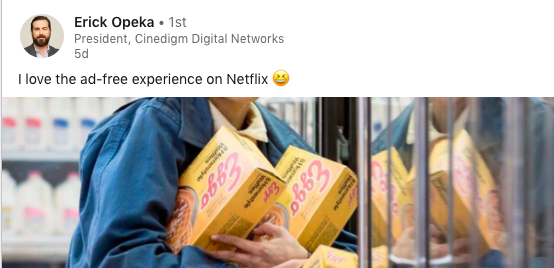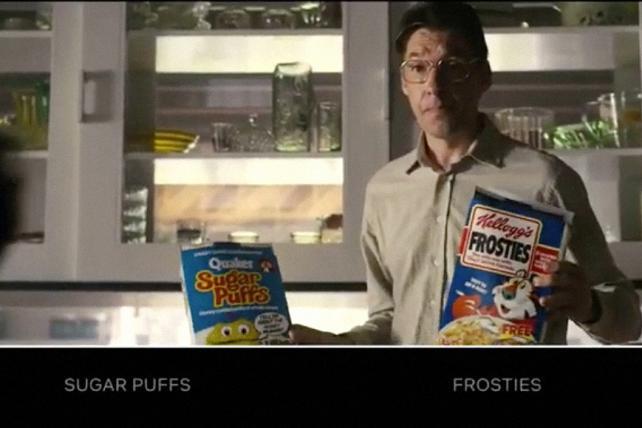Erick Opeka got a few laughs on LinkedIn when he posted this comment recently:

I’ve long argued that Netflix is going about brands and content in the wrong way- product placement like this, or these gigantic ads for Lavazza Coffee on Comedians in Cars Getting Coffee are actually more intrusive and gross than regular advertising. Heck, on the new season of Comedians… Seinfeld takes us on a five minute gushing tribute to Porsche that is longer than any commercial.

Aside from the few times when it makes legitimate sense to show a product for nostalgic reasons (and some of the Stranger Things tie-ins fall into this category), Netflix should move away from product placement and embrace smarter branded content. With nearly every brand you can think of making films these days, and all of them needing distribution, it’s a great opportunity for Netflix to get good content, lower its bills and bring in a new revenue stream without ruining the consumer experience.

Of course, this is dependent on maintaining its curatorial eye – use the humans at Netflix and the algorithm’s both to make sure that what you are licensing is entertaining (or enlightening, or otherwise valuable) to audiences. You can’t just start showing every crappy brand’s video, even if it wins a Cannes Lions (which are no arbiter of quality). But there are plenty of good branded content films/series out there, and many more in the pipeline and it’s astounding to me that Netflix isn’t pursuing this more aggressively.

Plus it gives them a marketing partner for each piece of content that often negates the need for a theatrical release – or when a theatrical is warranted, helps guarantee butts in seats through the extra marketing power of the brand partners. Yes, product placement does this too, but it’s much more advertising-oriented (and usually gross) than a simple logo at the beginning of the film, as most branded content is currently practiced.

FastCompany just ran a report about the product placement on Netflix, and points out that Netflix is pointing out that it didn’t accept payment for these placements. They’re clearly feeling a bit beat-up from the negative attention (there are gazillions of anti-product-placement stories online right now). Well-made branded content would negate this crap while expanding a smarter partnership structure.
Analysts keep writing stories predicting that Netflix will have to launch advertising, or an AVOD solution, to make up for slowing subscriber growth and to lower their debt. I don’t see this ever happening, as it makes for a poor customer experience. But switching from product placement to good brand relationships (and payments) via curated branded content would make for a much better option.
I’ll go a step further into (maybe) crazy-land and suggest that just as Netflix has upended the field of media, it can disrupt advertising for the better as well. If Netflix did this the right way – which would mean being super-selective, making brands work with trusted, quality producers directly (instead of with agencies) and with the real budgets it takes to make quality films/shows – then we could shift a lot of energy out of interruptive advertising and into quality content people want to watch. It would solve an actual consumer problem – wanting to skip ads – and a business one- wanting to break through the noise and reach those consumers skipping their ads – and an existential one – that it increasingly looks like content divorced from another profitable business is unsustainable.
I’m sure my leftist comrades are appalled at the thought of even more content being swayed by corporate interests. And this is a very real concern,. But it’s one we’re stuck with anyway, and one of the antidotes to that is better public support of media via a revamped approach – which could even mean requiring space for public media on Netflix – but that’s another article. Trust me – I am not arguing that we should only have branded content. That would suck (and be very much like the major networks anyway).
I’m just arguing that Netflix could do things better, and possibly disrupt a system (advertising) that is too busy taking micro-steps instead of making reach change.
WHAT I’M READING: FILM
Media’s Blame Game – AKA how not to do branded content, or media – This one from Om Malik (Founder of Gigagom) is making the rounds and it’s a good piece to keep in mind when contemplating my proposal above, as it shows how brands and their ads are slowly destroying our media. Well, that and a lack of planning or innovation on the part of media companies. It’s the must-read of the week.
The Doc Life: So What Exactly Does Successful Distribution Look Like? – When I go to film fests and talk to industry, one of the smartest voices in the room is always Tim Horsburgh, Director of Communications and Distribution at Kartemquin Films. Check out this interview with Film Independent, where he discusses the difficulties of film distribution.
Netflix is in the news nonstop: Here’s why Netflix says it lost US paid subscribers for the first time in eight years. And in other news, Netflix launched a mobile-only streaming plan in India for less than $3 per month, and some people think it’s a test-case for a similar service in the works for the world.
THE STREAMING WARS are heating up, and multiple publications weigh in:
The Financial Times warns that we are heading toward over saturation. SF Gate offers a list and breaks down the numerous services that will be available. (Spoiler: There’s too many). Forbes suggests that investors shouldn’t just look out for streaming dominance, but rather what companies are making smaller, but more innovative steps in the technology, and thereby lead the next media revolution (hint, this is the smartest take here). Yahoo Finance breaks down how Amazon and Disney will be the lead challengers of Netflix. And for some counter-argument, The Verge weighs in on Plex, which makes piracy a streaming service. They correctly note that the rise in piracy further reflects that it is getting too hard and expensive for consumers to watch what they want.
The Booming Podcast Business: Why Do You Listen? – I don’t know, because I don’t. But I know everyone else does.
And last, a plug for a great new film that I highly recommend, from a filmmaker I admire, and my friend, Rodney Evans: VISION PORTRAITS is a deeply personal documentary by award-winning filmmaker Rodney Evans (Brother to Brother) as he explores how his loss of vision may impact his creative future, and what it means to be a blind or visually impaired creative artist. It’s a celebration of the possibilities of art created by a Manhattan photographer (John Dugdale), a Bronx-based dancer (East Texas native Kayla Hamilton), a Canadian writer (Ryan Knighton) and the filmmaker himself, who each experience varying degrees of visual impairment. Using archival material alongside new illuminating interviews and observational footage of the artists at work, Evans has created a tantalizing meditation on blindness and creativity, a sensual work that opens our minds to new possibilities.
Opens August 9th in NYC at Metrograph
Opens August 23rd in LA at Laemmle Royal
WHAT I’M READING: BRANDED CONTENT
Quibi Acquires First News Program In Reported 8-Figure Deal With NBC – more Quibi news. The smart move here – Quibi shows that like Netflix, it is battling not to be just another service (here, on your phone), but an entire eco-system of content, so you don’t need to go anywhere else.
No, Your Brand Newsroom Is Not Really a ‘Newsroom’—and That Is OK – Another example of how creators making branded content need to embrace what branded content actually is rather than what they think it should be.
Olivia Munn is starring in a new cybersecurity thriller about the Sony hack . . . for IT managers? – Covering a dull subject for branded content? Just get a celebrity involved. Lenovo uses the woes of another company’s hack (Sony) to push its own cyber-security. Will be interesting to see whether this works.
Will GAIL’s ‘Hawa Badlo’ campaign shatter the branded content ceiling – Brand Equity brings up how we don’t have an effective way of measuring branded content impact.
People are reacting more to branded posts from Influencers than their own “normal” posts. What the heck? But it seems true. Instagram claims it’s not their algorithm just pushing branded posts, but call me skeptical. The writer points out that perhaps “influencers are actually putting in more work to create high-quality content for their ad partners than they do for their own content.” Whatever the reason, that’s good for the cart. If more people are interacting with branded posts, they might do more shopping as well. Then again, as the writer for FastCompany points out: “Influencers are competing for our mindshare in the extremely limited funnel of our feeds. As a result, everyone we follow seems to be selling us something all the time—even when they actually have more to say.”
Social tagging: branded content > distribution > influencers > Netflix > Quibi